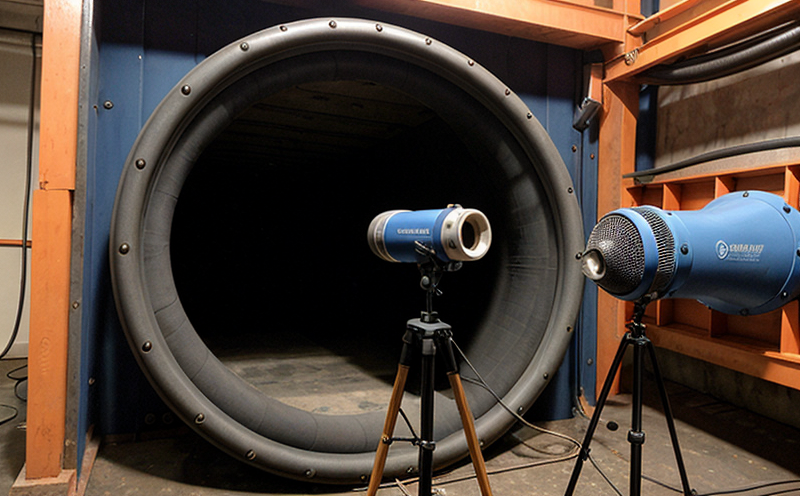ASTM E587 Ultrasonic Bonded Joint Testing
The ASTM E587 standard provides a method for evaluating the integrity of ultrasonically bonded joints in materials such as metals, plastics, and composites. This non-destructive testing (NDT) technique is widely used to ensure that bonded joints meet specific quality criteria without damaging the material or compromising its structural integrity.
Ultrasonic bond testing involves transmitting high-frequency sound waves into a specimen using a transducer probe. These waves travel through the bonded area and are reflected back when they encounter changes in density, such as at interfaces within the joint or flaws that may have formed during bonding. By measuring these reflections, technicians can assess the quality of the bond.
This method is particularly useful for detecting voids, delaminations, incomplete bonds, and other imperfections that could affect the reliability and durability of bonded structures. It offers a fast, accurate, and repeatable way to inspect joints in various industries including aerospace, automotive, construction, and electronics.
ASTM E587 defines the requirements for ultrasonic testing equipment, probe placement, and data interpretation. The standard specifies that the test should be conducted under controlled conditions to ensure consistent results. This includes maintaining a stable temperature environment and ensuring proper coupling between the transducer and the specimen surface.
The technique is versatile and can accommodate different types of joints and materials. For instance, it can evaluate lap joints, butt joints, or any other configuration where two surfaces are bonded together. The test setup involves placing a transducer in contact with one side of the joint while an identical probe is positioned on the opposite side.
After initiating the test, the reflected waves are analyzed to determine their amplitude and timing. A higher amplitude reflection indicates a better bond quality, whereas irregularities or missing reflections suggest potential issues within the joint. The results are typically presented in graphs showing waveforms and interpreted by experienced technicians to provide actionable insights.
The ASTM E587 method has been validated through numerous applications across various sectors. It is particularly valuable in industries where reliability is critical, such as aerospace manufacturing or medical device production. In these environments, even minor defects can have significant implications for safety and performance.
Scope and Methodology
| Parameter | Description |
|---|---|
| Type of Testing | Non-destructive testing using ultrasonic waves |
| Objective | Evaluation of the quality and integrity of bonded joints |
| Equipment | Ultrasonic transducers, signal processing equipment |
| Process | Transmitting ultrasonic waves into the joint, analyzing reflections for defects |
| Data Interpretation | Analyze waveform patterns to assess bond quality and identify flaws |
| Standard Reference | ASTM E587 - Standard Practice for Ultrasonic Bonded Joint Testing |
The ASTM E587 standard provides a comprehensive framework for conducting ultrasonic bond testing. It specifies the types of equipment required, the procedures to follow, and how to interpret the results accurately. Compliance with this standard ensures that tests are conducted consistently across different laboratories, enhancing reliability and comparability.
Eurolab Advantages
EuroLab offers unparalleled expertise in ASTM E587 ultrasonic bond testing, leveraging advanced technology and skilled personnel to deliver accurate and reliable results. Our state-of-the-art facilities are equipped with the latest ultrasonic testing equipment tailored for precision and repeatability.
Our experienced technicians ensure that each test adheres strictly to ASTM E587 guidelines, guaranteeing consistent quality assurance across all projects. We provide detailed reports highlighting bond integrity metrics such as peak amplitude, delay time, and reflection strength, enabling clients to make informed decisions about their manufacturing processes.
EuroLab's commitment to excellence extends beyond compliance with standards; we also offer customized solutions based on specific client needs. Whether you require routine quality checks or specialized testing for complex bonded structures, our team is dedicated to meeting your requirements seamlessly.
Competitive Advantage and Market Impact
EuroLab's proficiency in ASTM E587 ultrasonic bond testing provides a significant competitive edge by ensuring that our clients meet the highest quality standards. By adhering strictly to ASTM E587, we minimize risks associated with substandard bonded joints, thereby enhancing product reliability and safety.
Our ability to consistently deliver accurate test results contributes directly to improved customer satisfaction and trust. This is crucial in competitive markets where reputation plays a vital role in maintaining long-term relationships with clients.
In addition, our expertise in this area helps companies stay ahead of regulatory changes and industry trends. By being at the forefront of testing methodologies, EuroLab enables our clients to innovate confidently while ensuring compliance with international standards.





